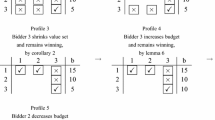Abstract
In this paper we consider the problem of designing a mechanism for double auctions where bidders each bid to buy or sell one unit of a single commodity. We assume that each bidder’s utility value for the item is private to them and we focus on truthful mechanisms, ones were the bidders’ optimal strategy is to bid their true utility. The profit of the auctioneer is the difference between the total payments from buyers and to tal to the sellers. We aim to maximize this profit. We extend the competitive analysis framework of basic auctions [9] and give an upper bound on the profit of any truthful double auction. We then reduce the competitive double auction problem to basic auctions by showing that any competitive basic auction can be converted into a competitive double auction with a competitive ratio of twice that of the basic auction. In addition, we show that better competitive ratios can be obtained by directly adapting basic auction techniques to the double auction problem. This result provides insight into the design of profit maximizing mechanisms in general.
Access this chapter
Tax calculation will be finalised at checkout
Purchases are for personal use only
Preview
Unable to display preview. Download preview PDF.
Similar content being viewed by others
References
Z. Bar-Yossef, K. Hildrum, and F. Wu. Incentive-compatible online auctions for digital goods. In Proc. 13th Symp. on Discrete Alg. ACM/SIAM, 2002.
A. Blum, T. Sandholm, and M. Zinkevich. Online algorithms for market clearing. In Proc. 13th Symp. on Discrete Alg., pages 971–980, 2002.
J. Bulow and J. Roberts. The Simple Economics of Optimal Auctions. The Journal of Political Economy, 97:1060–90, 1989.
E. H. Clarke. Multipart Pricing of Public Goods. Public Choice, 11:17–33, 1971.
S. DeVries and R. Vohra. Combinatorial Auctions: A survey. Unpublished manuscript, 2000.
A. Fiat, A. V. Goldberg, J. D. Hartline, and A. Karlin. Competitive generalized auctions. In Proc. 34rd ACM Symposium on the Theory of Computing. ACM Press, 2002. To appear.
Daniel Friedman and John Rust, editors. The Double Auction Market: Institutions, Theories, and Evidence. Addison Wesley, 1993.
A. V. Goldberg and J. D. Hartline. Competitiveness via consensus. Technical Report MSR-TR-2002-73, Microsoft Research, Mountain View, CA., 2002.
A. V. Goldberg, J. D. Hartline, A. Karlin, and A. Wright. Competitive Auctions. Submitted to Games and Economic Behavior., 2001.
A. V. Goldberg, J. D. Hartline, and A. Wright. Competitive Auctions and Digital Goods. In Proc. 12th Symp. on Discrete Alg., pages 735–744. ACM/SIAM, 2001. Also available as InterTrust Technical Report STAR-TR-99.09.01, 1999, http://www.star-lab.com/tr/tr-99-01.html.
T. Groves. Incentives in Teams. Econometrica, 41:617–631, 1973.
P. Klemperer. Auction theory: A guide to the literature. In Journal of Economic Surveys, pages 227–286. 13(3), 1999.
R. Preston McAfee. A dominant strategy double auction. In Journal of Economic Theory, volume 56, pages 434–450, 1992.
H. Moulin and S. Shenker. Strategyproof Sharing of Submodular Costs. to appear in Economic Theory.
R. Myerson. Optimal Auction Design. Mathematics of Operations Research, 6:58–73, 1981.
T. Sandholm and S. Suri. Market clearability. In Proc. of the 17th International Joint Conf. on Artificial Intelligence (IJCAI), pages 1145–1151, 2001.
W. Vickrey. Counterspeculation, Auctions, and Competitive Sealed Tenders. J. of Finance, 16:8–37, 1961.
P. Wurman, W. Walsh, and M. Wellman. Flexible double auctions for electronic commerce: Theory and implementation. In Decision Support Systems, volume 24, pages 17–27, 1998.
Author information
Authors and Affiliations
Editor information
Editors and Affiliations
Rights and permissions
Copyright information
© 2002 Springer-Verlag Berlin Heidelberg
About this paper
Cite this paper
Deshmukh, K., Goldberg, A.V., Hartline, J.D., Karlin, A.R. (2002). Truthful and Competitive Double Auctions. In: Möhring, R., Raman, R. (eds) Algorithms — ESA 2002. ESA 2002. Lecture Notes in Computer Science, vol 2461. Springer, Berlin, Heidelberg. https://doi.org/10.1007/3-540-45749-6_34
Download citation
DOI: https://doi.org/10.1007/3-540-45749-6_34
Published:
Publisher Name: Springer, Berlin, Heidelberg
Print ISBN: 978-3-540-44180-9
Online ISBN: 978-3-540-45749-7
eBook Packages: Springer Book Archive




